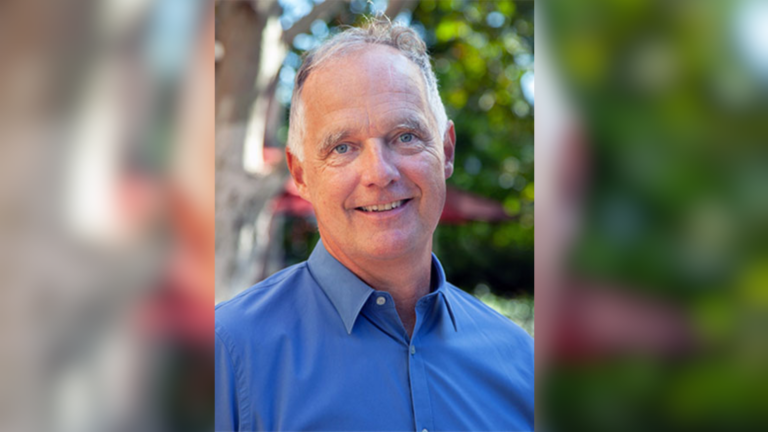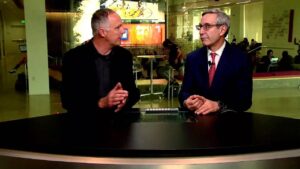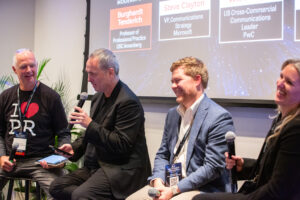
Photo courtesy of Professor Burghardt Tenderich
There has never been a better time to enter this dynamic industry. You can have meaningful, inspiring and well-compensated careers. You will be part of change. In fact, the only constant in your professional life will be change.
For Professor Burghardt Tenderich, the power of strategic communication presents one with incredible opportunities but also comes with a profound sense of responsibility. After all, his understanding of the tremendous influence of public relations began with a university lecture on Nazi propaganda.
“Learning about the ill-intentioned communication prowess of Joseph Goebbels and his fellow war criminals made a lasting impression on me. I realized the power of strategic communication, and that it can be applied to the worst purpose possible, but also to the best,” he said.
This early inspiration to leverage communication to shape the world around him for the better eventually led him to a distinguished career in technology PR, where he held senior positions such as Chief Communications Officer at a publicly traded software company and General Manager at a dynamic tech PR agency, working in Silicon Valley and Amsterdam. His career trajectory took a pivotal turn when he transitioned into academia, joining the University of California at Berkeley as the Executive Director of the Center for Entrepreneurship and Technology, before moving to USC Annenberg in 2010 as a professor of practice.
As the program director of the Online MS in Public Relations Innovation, Strategy and Management (PRISM) program, Tenderich is dedicated to fostering innovation and preparing the next generation of public relations professionals. He believes in the transformative power of education and the importance of staying ahead of industry trends. The “I” in PRISM, which stands for “Innovation,” encapsulates his vision of a highly applied, ever-involving, and industry-facing graduate experience that adapts to emerging technologies such as AI and Web3.
Below, Professor Tenderich shares his experiences in technology PR, his vision for the PRISM program, and the role of emerging technologies in the future of public relations.
Please tell us about your career journey and what led you to your current role at USC Annenberg. What inspired you to specialize in PR and strategic communication?
My first-ever class in university was a lecture series on Nazi propaganda. It was taught in the auditorium maximum at the University of Munich, the very same lecture hall where Nazi hate was spread in the 1930s and 1940s. Learning about the ill-intentioned communication prowess of Joseph Goebbels and his fellow war criminals made a lasting impression on me. I realized the power of strategic communication, and that it can be applied to the worst purpose possible, but also to the best. Soul-seeking after graduation, I developed a dual interest in public relations and communication technologies. I ended up spending the next fifteen-plus years working in technology PR, mostly in Silicon Valley, but also in Amsterdam, The Netherlands. After holding senior positions as chief communications officer at a publicly traded software company and general manager at a dynamic tech PR agency, I made the switch to academia and joined the University of California at Berkeley. As the executive director of the Center for Entrepreneurship and Technology, I worked with brilliant engineering student entrepreneurs on how to communicate their complex technological value propositions and how to position their products to target markets. A few years later, USC Annenberg invited me to present my credentials to be considered for a faculty position as a professor of practice, and I joined in the fall of 2010.
What do you find most rewarding about your role as the program director of PRISM?
Working with our students is inspiring and rewarding, as we faculty work tirelessly to help shape our students to reach their full potential. We have an incredibly diverse group of students from various backgrounds, from different states and countries. We all learn a lot from each other, which is very rewarding. I also enjoy identifying and bringing in top-level instructors, who typically work in very senior positions in the industry and enjoy bringing their vast experience to teach in the PRISM program for the benefit of our students.

Burghardt Tenderich interviews Richard Edelman, President & CEO of the public relations firm Edelman.
How has your professional experience shaped your vision for the PRISM program?
The PRISM program has been designed by current and former practitioners like myself for a highly applied, industry-facing graduate experience. For example, I noticed throughout my career how important it is for PR pros to be versed in what I call “the language of the boardroom.” In order to have a seat at the table as an adviser to the C-suite, you need to be able to discuss business and economic principles. Therefore, we created a designated PRISM course on business principles, which most students initially wish they didn’t have to take, but afterwards, tell us how valuable the learning experience was.
Focusing on the name for a moment, the PRISM program stands for Public Relations Innovation, Strategy and Management. Can you elaborate on the innovation aspect and what sets this program apart from other PR programs?
PRISM caters to the broadest possible definition of public relations: reaching internal and external stakeholders with strategically conceived content, via any media and method; traditional PR; social media advertising; influencer relations; Web3 technologies and many more. This greater world of PR has never been more exciting than now. The field grows in scope and in organizational impact, as the 20th century media environment has been completely disrupted in recent years. The key driver of this disruption is the “I” in PRISM, – innovation. I think this is where PRISM and our on-campus PR and advertising programs are unique: we double down on innovation. We overhaul our syllabi every semester as new technologies emerge and quickly establish themselves. One of our PRISM courses, “Emerging Game-Changers for Communication Practitioners,” was built a few months before OpenAI released ChatGPT, which ushered in the age of artificial intelligence in mainstream industries, including PR and communication. Generative AI represents a paradigm shift, and we enjoyed updating the course’s syllabus to meet AI on the leading edge of communication.

Professor Burghardt Tenderich moderates a panel at AI Deciphered.
Can you describe a memorable moment or achievement from your time with the PRISM program?
The PRISM program is young, as it was just launched in Fall 2023. It has already grown into a robust cohort of students and continues to evolve. A memorable moment for me was USC’s May 2024 commencement, where the first small cohort of PRISM students walked. We had gathered the night before for dinner, which was the first time any of us had met in person. It was an extraordinary experience as we all felt we knew each other so well after working together in a virtual classroom. It truly felt like we were closely connected— which speaks to the power of technology-enabled online education.
How do you stay current with industry trends and incorporate them into the PRISM curriculum?
As USC Annenberg’s public relations and advertising faculty, we work to stay extremely close to industry leaders. This manifests itself in recruiting senior practitioners to teach in our programs. Our main differentiator is the USC Annenberg Center for Public Relations, where our colleague Professor Fred Cook, former CEO of one of the largest PR agencies, has convened a truly stunning board of advisers, comprised of over 40 chief communication officers and agency CEOs and many other very senior leaders. The Center’s board convenes every semester and advises on trends in industry. They meet our students, hire our alumni and help all of us stay current. They also guest lecture in class, and even teach PRISM courses.
Your research and teaching have focused on Web3 technologies for communicators. What role do you see technology playing in the future of public relations?
Web3, which I define as the combination of blockchain, metaverse, generative AI, with a little IoT—Internet of Things—sprinkled on top, represents the next major disruption not only for communicators, but pretty much every aspect of societies. We can already see how this is beginning to reshape the world of PR and marketing communication. Brands establish “real estate” presences in the metaverse. They enhance their IRL—in real life—products and services with NFT—non-fungible token—collectibles, which is a blockchain application, to give only two examples. Generative AI changes the job profiles of organizational communicators. I now tell our students they will not write first drafts of news releases, Q&As or briefing documents. Instead, they will edit and curate what generative AI has drafted. They will be “prompt engineers,” meaning, they will write sophisticated instructions for AI to generate meaningful content. This also means many traditional jobs will be lost, and new ones will be created.
What advice would you give to students who are considering a career in public relations and strategic communication?
There has never been a better time to enter this dynamic industry. You can have meaningful, inspiring and well-compensated careers. You will be part of change. In fact, the only constant in your professional life will be change.
Looking ahead, what are your hopes and goals for the future of the PRISM program and its students?
Our goal for the PRISM students and alumni is to have amazing careers in their industry of choice, to rise to leadership positions and make meaningful contributions to the world of public relations and strategic communication. The brand vision for the M.S. PRISM is to be recognized as the preeminent online graduate degree program for future leaders in the greater public relations industry in the United States and beyond.
Learn more about the online MS in Public Relations Innovation, Strategy and Management (PRISM) program.



